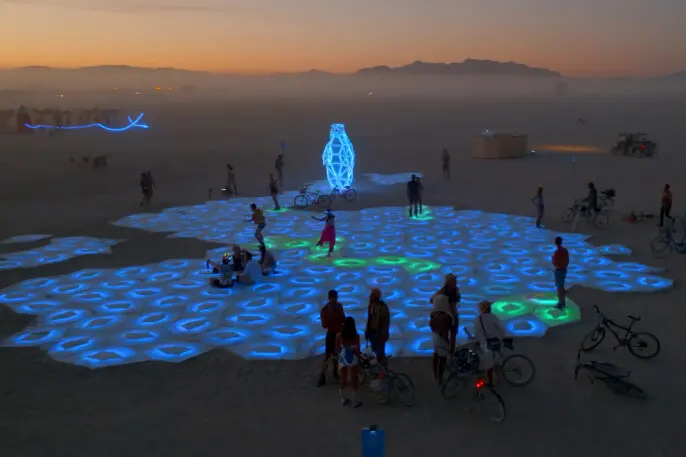Easy riddle: Where in the world can you stumble upon an ornate temple, a gravity-defying sculpture made of trucks, and a giant typewriter big enough to climb, all the while wandering around the desert with 80,000 other people?
Burning Man, of course.
The arts and culture festival that pops up in the Nevada desert every year is back after a two-year break for COVID-19, with ever-more-outrageous mutant vehicles, mammoth chairs, and a 48-foot-tall wood bell tower. But in the middle of Black Rock City, an even cooler surprise awaits: a glowing, 8,000-square-foot installation inspired by the world’s largest body of floating ice—the Ross Ice Shelf in Antarctica. Dubbed The Last Ocean, the installation resembles a fractal patchwork of 300 LED platforms that come alive when people step, dance, or do yoga on them. It was designed by interactive artist Jen Lewin, with the goal of capturing the fragility of our natural landscape, prompting people to reflect on their impact on the environment.
“I was both inspired by the Ross Ice Shelf’s natural beauty [and] terrified by the melting and potential destruction of such an important landscape,” says Lewin, whose other interactive exhibitions and installations include a motion-sensing light sculpture and a touch-activated constellation of circles inspired by Australian tidal pools.

To create The Last Ocean, Lewin partnered with Ocean Plastic Technologies, a South African company that collects and repurposes ocean plastic from South African beaches to source more than 10,000 pounds of plastic (both from the ocean and ocean-bound), and used about the same amount of recycled-glass fiber to make the sculpture more durable. “We are excited by the opportunity to show the world that reclaimed plastic trash can be used to create beautiful, sophisticated artwork,” says Lewin.
After Burning Man, the installation will travel to Detroit, San Francisco, and Arizona, meaning that, at the end of the festival, it isn’t intended to be dismantled and tossed. “My team and I are not moving reclaimed plastic into something disposable,” says Lewin. We are capturing plastic trash and recycled content to create public art that can last the test of time.”
My only question is, will it last the test of dance?
Recognize your brand’s excellence by applying to this year’s Brands That Matter Awards before the early-rate deadline, May 3.